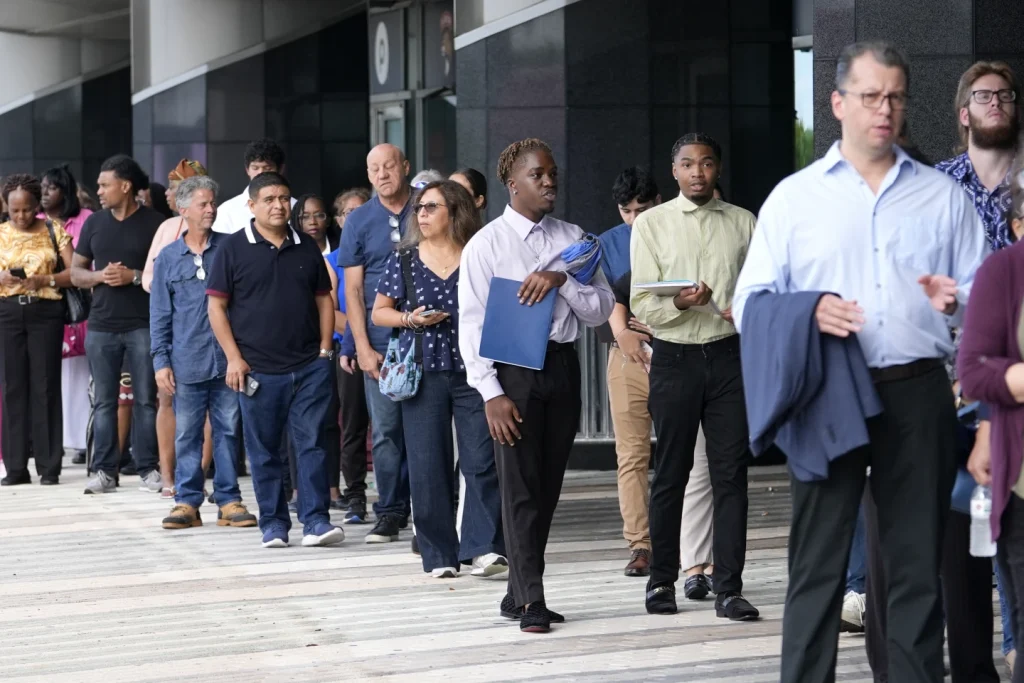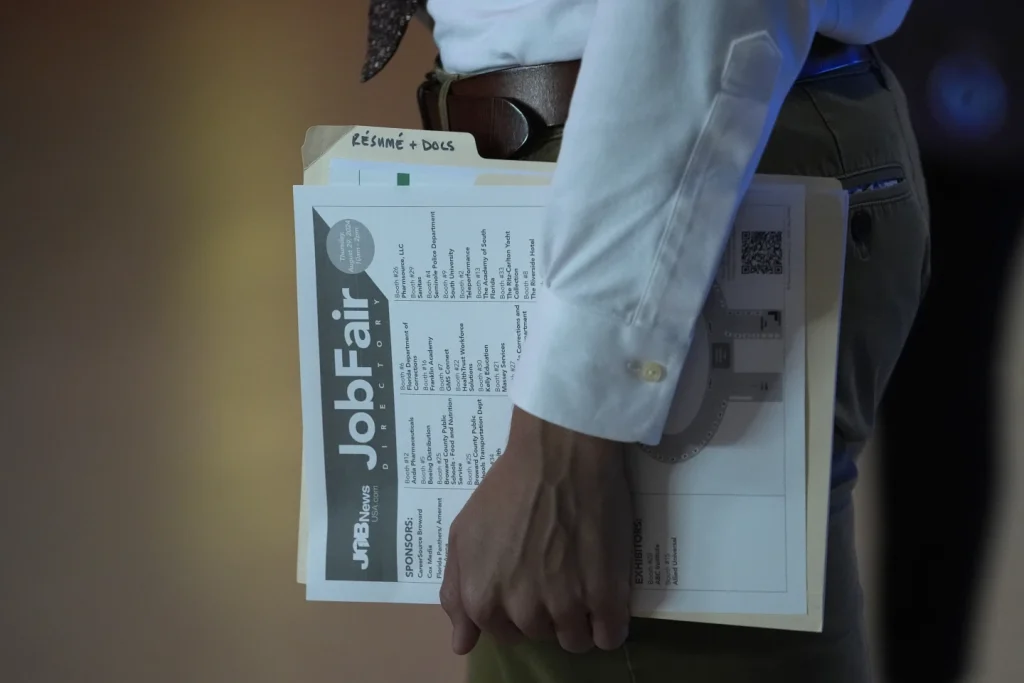The American labor market has undergone a profound transformation over the past few years, transitioning from a period of intense growth and unprecedented opportunities to one characterized by hesitancy and uncertainties.
The experiences of individuals like Joovay Arias, who was laid off by music streaming service Spotify, exemplify the challenges that many job seekers currently face.
While the job market was exceptionally robust in recent times, it has now evolved into a complex landscape where job security appears stable for many current employees, but obtaining new employment has become an arduous task for those seeking work.
Joovay Arias’s journey is emblematic of this transition. Previously enjoying a flurry of recruitment opportunities during his job search in 2019, he encountered an unexpected struggle when attempting to find new employment after his layoff.
His anticipation of a quick transition from one role to another was met with the harsh reality of a protracted job search that extended over a year.
This scenario serves as a microcosm of the broader labor market, where a stark contrast exists between those who are securely employed and those who are navigating the turbulent waters of job searching.
The current state of the labor market can be described as paradoxical. On one hand, layoffs are relatively low, and those who hold jobs report a sense of stability and security.
Nick Bunker, the economic research director for North America at the Indeed Hiring Lab, articulates this sentiment effectively: for those currently satisfied in their roles, the present is decidedly favorable.
However, for the unemployed or those wishing to transition to new opportunities, the prospects are far bleaker than in previous years.
Statistical evidence supports this trend. Since peaking in March 2022, the number of job openings has fallen by more than a third, displaying a fundamentally altered hiring landscape.
This decline is especially reflected in the temporary-help sector, which has seen job reductions for 26 of the past 28 months.
Temporary positions often act as a precursor to full-time employment; consequently, the decline in temp jobs signals potential softening in the job market—a notion echoed by various Federal Reserve regional banks that have reported a deceleration in hiring activities.
The narrative of hesitance extends to staffing agencies, which have noted that businesses are becoming increasingly selective in their hiring practices, illustrating a newfound caution in the labor market.
Job-hopping, which characterized the workforce during the pandemic recovery as workers sought better compensation and conditions, has also witnessed a marked decrease.
This slowdown reflects a growing fear among employees regarding job security and the difficulties of finding new roles. The stark statistic from July, showing only 3.3 million individuals voluntarily left their jobs compared to the peak of 4.5 million in April 2022, reinforces this notion.
Such figures underscore a broader sentiment: workers are remaining in their current positions longer, driven by the perception that new opportunities may be scarce or less favorable.
The annual revisions to employment data by the Labor Department further exemplify the evolving employment landscape, revealing that the economy had added 818,000 fewer jobs than previously estimated in the twelve months ending in March.
These adjustments not only reflect the current job market’s foreboding atmosphere but also point to a shift in the economic landscape’s momentum.
It is critical to contextualize the current cooling of the labor market within the broader economic framework. The dramatic job growth experienced during 2021 and 2022 was forged in the fires of recovery from the COVID-19 pandemic—the most explosive growth on record, with unprecedented levels of hiring.
Companies were compelled to respond to soaring demand, leading employers to raise wages and offer enticing bonuses as they vied for a limited pool of talent. Economists posit that a moderation in hiring and wage growth may serve to alleviate inflationary pressures and ultimately ensure sustainable economic health.
Without such adjustments, the economy risked overheating, potentially prompting the Federal Reserve to impose aggressive monetary tightening that could lead to a recession.
When drawing comparisons with the post-Great Recession recovery, the contrast becomes stark. The labor market’s sluggish recovery from 2007 to 2009 took over six years to regain lost jobs, whereas the pandemic-induced job losses of 2020—totaling over 22 million—have largely been recovered within two and a half years.
This rapid rebound created an environment of worker leverage, with many taking bold steps to reevaluate their career trajectories.
Yet, as we stand at this juncture, the equilibrium of the labor market has shifted, resulting in an atmosphere laden with uncertainty.
Companies are reevaluating their hiring strategies, leading to fewer positions and greater selectivity. Job seekers like Joovay Arias are forced to navigate this volatile landscape with caution and resilience, reflecting a fundamental change in the dynamics of employment in America.
The complexity of the contemporary labor market has significantly intensified, particularly for entry-level job seekers, as articulated by Glassdoor’s Terrazas, who highlights the profound impact of ongoing layoffs in sectors such as technology, finance, and professional services over the past year and a half.
This trend has effectively inundated the job market with highly skilled and experienced individuals, thereby complicating the prospects for recent graduates and those without extensive professional experience.
The competitive landscape has shifted drastically, as these seasoned job seekers, with their two to ten years of experience, inadvertently push entry-level candidates further down the hiring hierarchy, creating a scenario where the latter find themselves at a distinct disadvantage.
While economic indicators suggest that the economy remains resilient, recording a robust growth rate of 3% annually from April through June, an undercurrent of job insecurity has begun to permeate the perceptions of the workforce.
Recent surveys conducted by the New York Fed reveal that anxiety surrounding job loss is at its highest since 2014, reflecting a collective sentiment that echoes the aftermath of the Great Recession of 2008-2009.
This pervasive anxiety can be attributed to a stark contrast between current hiring conditions and the expansive job market of 2021 and 2022, which many individuals still use as a reference point.
The experience of recent graduates, such as Abby Neff, who has found her aspirations tempered by the harsh realities of job hunting in journalism, underscores the challenges faced by those entering the labor market.

Despite her proactive efforts during her academic journey—editing a campus magazine and networking—Neff’s experiences have been marked by an unsettling lack of responsiveness from potential employers, a phenomenon often referred to as being “ghosted.”
Concurrently, Arias, a former software engineer, illustrates the lengths to which job seekers are compelled to go in order to secure employment, having turned to ride-sharing as a means of generating income while actively pursuing job leads.
His journey reflects the broader sense of frustration experienced by many job seekers, characterized by an alarming frequency of uncommunicative employers and automated responses that leave candidates in uncertainty about their applications.
Collectively, these narratives depict a labor market that, while ostensibly thriving, maintains an underlying current of disquiet that is felt by those who navigate it, engendering a climate of anxiety and competition that complicates the aspirations of many individuals in search of fulfilling career opportunities.
In conclusion, the current labor market represents a complex tapestry of security for some and uncertainty for others.
While employment rates remain relatively stable, the journey to securing a new position has grown increasingly challenging.
Analyzing these trends highlights the dual nature of the labor market: on one end, there is a sense of job security among current employees, while on the other, an entire demographic remains in flux, facing the daunting task of finding new employment amidst a cooling marketplace.
As economic conditions continue to evolve, understanding these dynamics is essential for policymakers, businesses, and workers alike, paving the way for a resilient and adaptable workforce in the future.
